As we have seen in past posts, the early Jesus movement – which ultimately became Christianity – originated in a polytheistic environment: people of the Roman Empire worshiped multiple female and male deities. This means that Jesus himself, his earliest followers and those who later identified as Christians lived and worked among devotees of Aphrodite/Venus, Athena, Asklepios, Artemis/Diana, Dionysos/Bacchus, and Apollo/Zeus and many other deities well into the later imperial era.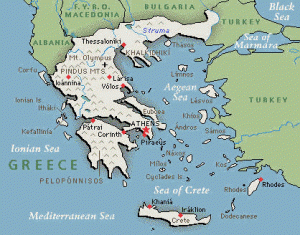
Here we will examine a more unfamiliar deity from what is now northern Greece and Bulgaria: the Thracian Horseman. The Horseman’s popularity is significant for several reasons: 1) people venerated him even as the church grew at Philippi, Thessaloniki and other cities in this region; 2) women were among the devotees of this male god and probably among its leaders; and 3) the Horseman’s cult was connected to his involvement with healing and immortality, which were also important to devotees in pagan cults and early Christianity.
The Horseman Cult and Monuments
The ancient regions of Macedonia, Thrace, Dacia, Moesia Inferior, and Illyricum – now in Greece and Bulgaria – have yielded archaeological remains of many cults that existed before, during and long after the time of St. Paul and the earliest Jesus followers. The Thracian Horseman (also known as the Thracian Hero) is among the deities whose cult is attested by thousands of votive and funerary reliefs (Hoddinott, 161); because he is related to and assimilated (syncretized) with other more familiar deities, we can draw conclusions as to why he attracted devotees in large numbers and how his cult influenced Christianity as it developed. Pictured here is a sampling of Horseman monuments and grave stelai from Philippi, Neapolis (today’s Kavala, the port of Philippi), Serres, and the island of Thasos.
Iconographically, the Horseman/Hero is most often depicted as a rider on horseback galloping or walking to the viewer’s right. [Left: Horseman monument showing tree and serpent, Kavala Museum.] 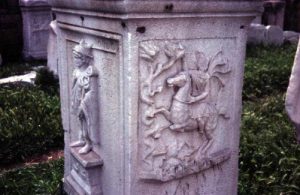 The rider, always male, wears a cape and other riding attire. Generally the horse faces or jumps back from a tree entwined by a serpent or behind which a boar appears; in some examples, there is a flowering bush but no serpent. Sometimes a veiled woman appears in the scene; in other examples there may be a hound or other animal associated with the hunt. Inscriptions in both Latin and Greek on isolated monuments are addressed to the god Heros; some actual sanctuaries to him have also been discovered (especially in Bulgaria), so there is evidence for a viable cult as well as sporadic worship of a less organized nature (Abrahamsen, 70).
The rider, always male, wears a cape and other riding attire. Generally the horse faces or jumps back from a tree entwined by a serpent or behind which a boar appears; in some examples, there is a flowering bush but no serpent. Sometimes a veiled woman appears in the scene; in other examples there may be a hound or other animal associated with the hunt. Inscriptions in both Latin and Greek on isolated monuments are addressed to the god Heros; some actual sanctuaries to him have also been discovered (especially in Bulgaria), so there is evidence for a viable cult as well as sporadic worship of a less organized nature (Abrahamsen, 70).
Many of the Horseman monuments “are old finds without any information about the place where they were found or the circumstances of finding” (Hampartumian, 5; Abrahamsen, 73). However, what we can know tells us that devotees of the Horseman were both male and female, came from rural and urban areas, and honored him with votive offerings and in funerary contexts. Greek influence played a large part in the Horseman’s cult (Hampartumian, 5-11; Abrahamsen, 73).
Sanctuaries found in Bulgaria reveal additional aspects of the Horseman cult. At a wealthy estate at Chatalka, a domestic shrine of the Hero contained rich female burials, indicating that those women may have been cult priestesses. In Sardica, modern Sofia, the sanctuaries seem mainly to be on heights or near springs, both of which were present at Philippi. 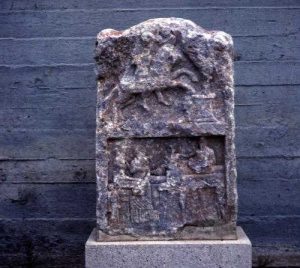 [Right: funerary monument, Philippi Museum, showing Thracian Horseman on top, funerary banquet on bottom.] In some of these shrines, the Hero cult has been syncretized to those of other (Graeco-Roman) deities, and it is quite possible that the original cult at the site was that of the Horseman. Additional Thracian shrines to the Hero and other gods have been constructed of natural materials such as mountain peaks and streams, including those at Glava Panega, Daskalovo and Lilyache, all in Bulgaria. Some old cult centers, dedicated to the Horseman, appear to have developed into healing springs and subsequently Roman spas. The overwhelming quantity of votive tablets to the Three Nymphs in South Thrace, found in shrines associated with springs, especially warm mineral waters, suggests the continued popularity, primarily among Thracians, of a fertility cult in this area (Hoddinott, 160-65; Abrahamsen, 75). Water was long associated with powerful goddesses in their healing capacity (Abrahamsen, passim).
[Right: funerary monument, Philippi Museum, showing Thracian Horseman on top, funerary banquet on bottom.] In some of these shrines, the Hero cult has been syncretized to those of other (Graeco-Roman) deities, and it is quite possible that the original cult at the site was that of the Horseman. Additional Thracian shrines to the Hero and other gods have been constructed of natural materials such as mountain peaks and streams, including those at Glava Panega, Daskalovo and Lilyache, all in Bulgaria. Some old cult centers, dedicated to the Horseman, appear to have developed into healing springs and subsequently Roman spas. The overwhelming quantity of votive tablets to the Three Nymphs in South Thrace, found in shrines associated with springs, especially warm mineral waters, suggests the continued popularity, primarily among Thracians, of a fertility cult in this area (Hoddinott, 160-65; Abrahamsen, 75). Water was long associated with powerful goddesses in their healing capacity (Abrahamsen, passim).
Concern with Healing and Immortality
As noted, the Horseman has been linked to a number of cults, deities, influences and ethnic backgrounds in these Greek and Bulgarian regions. Various combinations are witnessed. Such links provide explanations for why the Horseman attracted adherents well into the second and third centuries CE when Christianity was becoming established throughout the Empire.
The healing god Asklepios is linked to the Horseman near Daskalovo, Bulgaria. The Rudarska River containing mineral water flows nearby – a further association with healing and miracle cures. The cult was housed in a shrine that consisted of an outer yard and a temple that contained a cella and naos, typical rooms in classical temples. Coins indicate that most of the shrine’s usage occurred between about 200 and 360 CE. More than 140 marble and statuary fragments were also found, many depicting the Horseman and some Asklepios [shown at left]. Inscriptions on the monuments bore Latin, Greek and Thracian names. 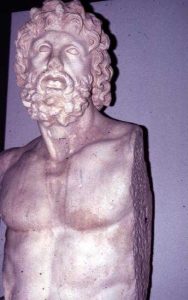 Further, the occurrence of this one Horseman shrine with specifically prophylactic uses suggests that there may be more yet to be found and that healing was indeed one of the Hero’s functions (Abrahamsen, 70).
Further, the occurrence of this one Horseman shrine with specifically prophylactic uses suggests that there may be more yet to be found and that healing was indeed one of the Hero’s functions (Abrahamsen, 70).
Artemis (Latin Diana and sometimes the Thracian Bendis) is another deity linked with the Horseman, with both connected to healing and the afterlife. The Horseman is found on grave stelai throughout the region, indicating that the deceased man, woman or child was seen either as becoming deified him/herself and/or united with the god. Furthermore, the serpent and tree in the depictions are in some cases symbols of the afterlife (Hoddinott, 174), and both the Horseman and Artemis granted immortality by guaranteeing the health and well-being of the next generation (Abrahamsen, 71).
The link between Artemis and the Horseman is particularly clear at Philippi. The Horseman image appears seven times among the rock reliefs on the acropolis hill, since the majority of the approximately 200 reliefs carved on the acropolis hill around 200 CE depict Artemis and possibly priestesses of her cult (Hoddinott, 169-75; Abrahamsen, 69-70). 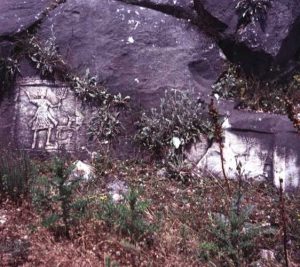 We have earlier discussed the Philippi rock reliefs, showing that the pagan cults survived well into the Christian era. [Right: Sample rock reliefs, Philippi acropolis hill.]
We have earlier discussed the Philippi rock reliefs, showing that the pagan cults survived well into the Christian era. [Right: Sample rock reliefs, Philippi acropolis hill.]
It is in the concern with immortality that the Horseman was at times assimilated to the wine god, Dionysos/Bacchus. The excavators at Philippi identified several rock reliefs on the acropolis hill as depicting Dionysos (Abrahamsen, 71). Also, two pieces of evidence from the Philippian countryside support the existence of Dionysiac mysteries in the area and women’s involvement in them. One is an inscription from the village of Podgora dated to the early third century CE which relates that a man, Zipas, bequeathed 120 denarii on behalf of himself, his wife, Kleudis, and their children to the mysteries of Dionysos for roses to be burnt annually by cult members at the grave (Portefaix, 104-05; Perdrizet, 304-05; Collart, 417 and n. 1; Abrahamsen, 71-72).
The second inscription, from the village of Doxato, more explicitly speaks of female ecstatics and participants. Found in a church, the inscription, also dated to the third century CE, is dedicated to a young boy who had been initiated into the Dionysiac mysteries. The dedication, written in Latin, mentions “basket-bearing Naiads” and “tattooed women initiated into the mysteries of Bromios” (Portefaix, 105; Collart, 419; Abrahamsen, 72).
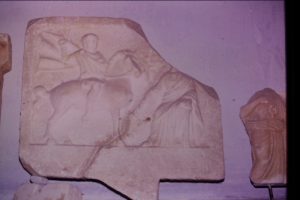 The archaeologists who discovered these inscriptions drew significant cultic connections between Dionysos and the Horseman/Hero. Several sculptural examples of ties between the two – two from tombs at Podgora and Reussilova, one on a votive relief from Melniki and one from a metope from Thasos – show that the cults of both deities were deeply concerned with the survival of individual souls after death (Collart, 423; Abrahamsen, 72). [Left: Horseman monument, Thasos Museum.] The archaeologist continues:
The archaeologists who discovered these inscriptions drew significant cultic connections between Dionysos and the Horseman/Hero. Several sculptural examples of ties between the two – two from tombs at Podgora and Reussilova, one on a votive relief from Melniki and one from a metope from Thasos – show that the cults of both deities were deeply concerned with the survival of individual souls after death (Collart, 423; Abrahamsen, 72). [Left: Horseman monument, Thasos Museum.] The archaeologist continues:
…the religious associations that were connected with the hunter Heros, or with a Thracian divinity…were charged, just like the Dionysiac funerary associations, with enacting on the tombs ritual ceremonies for the deceased, and the sculpted figure of the Horseman, which decorates so many funerary monuments, expressed the hope of enjoying,…in the heavenly procession, a happy and everlasting life (Collart, 423; Abrahamsen, 72).
Hence the dual nature of the Horseman cult in the region, vis-à-vis afterlife beliefs and practices: 1) when an individual died, s/he was guarded or led to heavenly places by the Horseman; 2) for years, perhaps a generation, after the person’s death, the association of believers devoted to the deity kept watch over the grave and commemorated the deceased in some way, probably by rites similar or identical to the rosalia or parentalia, Roman funerary rites (Collart, 475-85; Abrahamsen, 72).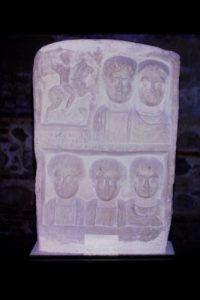
There is a further connection between at least three of these deities: Dionysos, the Horseman/Hero and Artemis/Diana/Bendis. In several of the rock reliefs at Philippi, Artemis holds a branch or a bough or is pictured near a tree (Abrahamsen, 72-73). This branch, bough or tree most likely relates to immortality, fertility and nature aspects of the plant, animal and human worlds (Abrahamsen, 57-58). [Right: Horseman funerary monument, Serres Museum.] Similarly, two heroized deceased persons are portrayed on a funerary stele from Thasos. On one monument, the Horseman/Dionysos makes a gesture of benediction, and the other depicts a female personage in a large garment who holds in her right hand an ivy branch covered with leaves. Another monument, a votive relief from Chalkis, Greece, depicts a Bendis figure between a bearded deity who holds a cornucopia and a smaller person, the (female) devotee. These would certainly suggest a cultic (i.e., not only symbolic or iconographic) link between the two deities in this region, one which encompassed the funerary, votive and healing aspects of each (Collart, 423, 436-37; Abrahamsen, 72-73).
Conclusions
The combined evidence we have cited suggests a number of takeaways.
- While the Horseman is not mentioned in the New (Christian) Testament texts, his image – in both votive and funerary contexts – is widely attested in a region that had a long association with the earliest witnesses to the Jesus movement and its missionaries, namely the authentic letters of St. Paul, especially Philippians and I Thessalonians.
- The Horseman/Hero cult, especially as syncretized with other deities such as Asklepios, Artemis and Dionysos and as shown in his iconography (branch/bough, serpent) and context (water, springs), was concerned with issues important to the average devotee: healing and immortality.
- There is some evidence for women leaders/priestesses in the Horseman cult.
The Thracian Horseman/Hero was one of the most popular deities in Thrace and other Greek and Bulgarian regions during the second and third centuries CE for worshippers of all social strata and ethnic origins. While Christianity was gaining a foothold throughout the Empire at this time, pagan cults such as that of the Horseman not only survived but thrived. As we have seen, there are reasons for this survival: the old ways met people’s everyday needs.
We must always keep this in mind as we read “official” texts of Christianity that attempt to assert Christianity’s superiority. Christian leaders and apologists, both religious and secular, tried diligently to convert pagans to the faith, eradicate heresy, and destroy all remnants of the old rites and structures. In many ways, for several centuries, they were only partially successful.
Resources
Abrahamsen, Valerie A. Women and Worship at Philippi: Diana/Artemis and Other Cults in the Early Christian Era. Portland, ME: Astarte Shell Press, 1995.
Collart, Paul. Philippes: Ville de Macédoine depuis ses origines jusqu’à le fin de l’époque romaine. Paris, 1937.
Ferguson, Everett, ed. Encyclopedia of Early Christianity (New York and London: Garland Publishing, Inc., 1990) 80.
Hammond, N.G.L. “Via Egnatia,” in N.G.L. Hammond and H.H. Scullard, eds. Oxford Classical Dictionary, 2nd ed., 1118. Oxford: Clarendon Press, 1970.
Hampartumian, Nubar. Moesia Inferior (Romanian Section) and Dacia. Etudes préliminaires aux religions orientales dans l’empire romain, Vol. 74. Leiden: Brill, 1979.
Hoddinott, R.F. The Thracians. New York: Thames and Hudson, Inc., 1981.
Perdrizet, Paul. “Inscriptions de Philippes: Les Rosalies,” BCH 24 (1900) 299-333.
Portefaix, Lilian. Sisters Rejoice. Uppsala: Coniectanea Biblica; New Testament Series 20, 1988.
